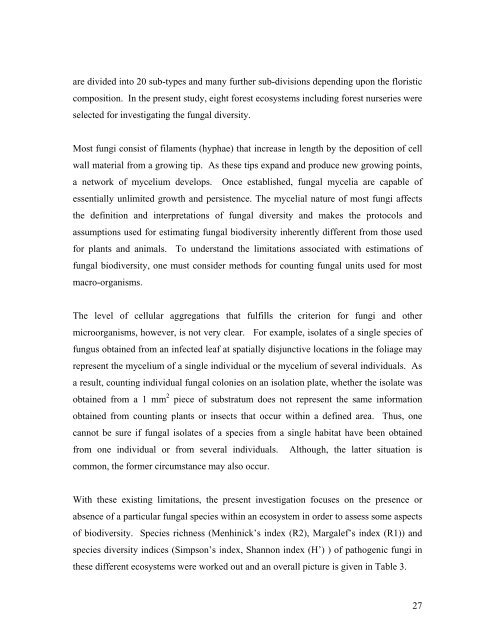Biodiversity of Plant Pathogenic Fungi - Kerala Forest Research ...
Biodiversity of Plant Pathogenic Fungi - Kerala Forest Research ...
Biodiversity of Plant Pathogenic Fungi - Kerala Forest Research ...
Create successful ePaper yourself
Turn your PDF publications into a flip-book with our unique Google optimized e-Paper software.
are divided into 20 sub-types and many further sub-divisions depending upon the floristic<br />
composition. In the present study, eight forest ecosystems including forest nurseries were<br />
selected for investigating the fungal diversity.<br />
Most fungi consist <strong>of</strong> filaments (hyphae) that increase in length by the deposition <strong>of</strong> cell<br />
wall material from a growing tip. As these tips expand and produce new growing points,<br />
a network <strong>of</strong> mycelium develops. Once established, fungal mycelia are capable <strong>of</strong><br />
essentially unlimited growth and persistence. The mycelial nature <strong>of</strong> most fungi affects<br />
the definition and interpretations <strong>of</strong> fungal diversity and makes the protocols and<br />
assumptions used for estimating fungal biodiversity inherently different from those used<br />
for plants and animals. To understand the limitations associated with estimations <strong>of</strong><br />
fungal biodiversity, one must consider methods for counting fungal units used for most<br />
macro-organisms.<br />
The level <strong>of</strong> cellular aggregations that fulfills the criterion for fungi and other<br />
microorganisms, however, is not very clear. For example, isolates <strong>of</strong> a single species <strong>of</strong><br />
fungus obtained from an infected leaf at spatially disjunctive locations in the foliage may<br />
represent the mycelium <strong>of</strong> a single individual or the mycelium <strong>of</strong> several individuals. As<br />
a result, counting individual fungal colonies on an isolation plate, whether the isolate was<br />
obtained from a 1 mm 2 piece <strong>of</strong> substratum does not represent the same information<br />
obtained from counting plants or insects that occur within a defined area. Thus, one<br />
cannot be sure if fungal isolates <strong>of</strong> a species from a single habitat have been obtained<br />
from one individual or from several individuals. Although, the latter situation is<br />
common, the former circumstance may also occur.<br />
With these existing limitations, the present investigation focuses on the presence or<br />
absence <strong>of</strong> a particular fungal species within an ecosystem in order to assess some aspects<br />
<strong>of</strong> biodiversity. Species richness (Menhinick’s index (R2), Margalef’s index (R1)) and<br />
species diversity indices (Simpson’s index, Shannon index (H’) ) <strong>of</strong> pathogenic fungi in<br />
these different ecosystems were worked out and an overall picture is given in Table 3.<br />
27

















